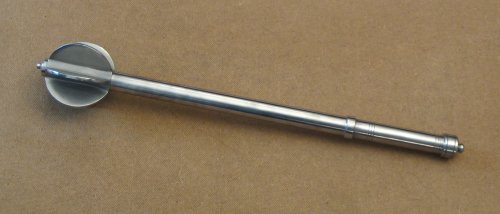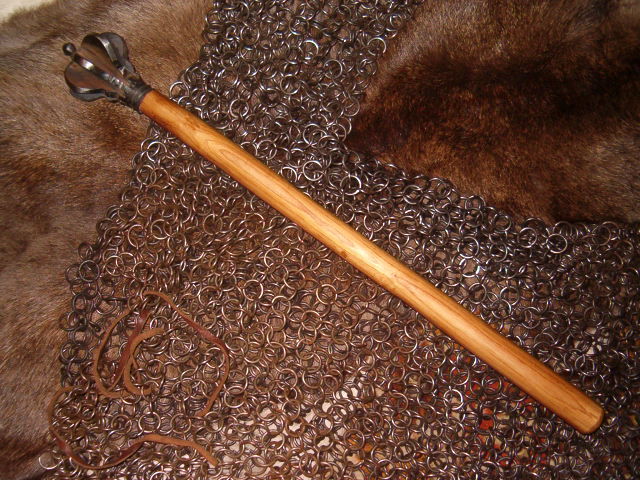
I've seen a few examples of maces with rounded flanges (such as one attached) was there a specific reason anyone knows of for rounded flanges, since from what I've seen most flanged maces seemed to be primarily triangular to help penetration in armor I suppose, so if anyone knows of a purpose for round vs triangular flanges it be appreciated, thanks
 Attachment: 17.26 KB
Attachment: 17.26 KB


Hi,
I seem to remember Oakeshott writing something about the evolution of mace-heads in A Knight and his Weapons...
... hang on a sec...
'During the later fifteenth century maces became shapely weapons, in fact, from about 1440 to 1510 most weapons were not only very beautiful in form - more so than they had ever been before and would ever be again - but were magnificently made...'
<blah blah blah>
'...The mace of this period was a small weapon with a flanged head; the flanges were acutely pointed, in contrast to the flatter forms of the earlier types. This shape, however, seems to have had its disadvantages: instead of merely denting and crushing armour, its sharp flanges tended to punch through it, causing the mace to get completely stuck and so become wrenched from it's owner's hand. By the early sixteenth century the flanges of mace-heads became flatter again, but much more ornamental than before; they got bigger too.'
Hope this goes towards answering your question.
Thanks,
Ant
I seem to remember Oakeshott writing something about the evolution of mace-heads in A Knight and his Weapons...
... hang on a sec...
'During the later fifteenth century maces became shapely weapons, in fact, from about 1440 to 1510 most weapons were not only very beautiful in form - more so than they had ever been before and would ever be again - but were magnificently made...'
<blah blah blah>
'...The mace of this period was a small weapon with a flanged head; the flanges were acutely pointed, in contrast to the flatter forms of the earlier types. This shape, however, seems to have had its disadvantages: instead of merely denting and crushing armour, its sharp flanges tended to punch through it, causing the mace to get completely stuck and so become wrenched from it's owner's hand. By the early sixteenth century the flanges of mace-heads became flatter again, but much more ornamental than before; they got bigger too.'
Hope this goes towards answering your question.
Thanks,
Ant
alright cool that makes sense thanks
I made mine pointy, if for no other reason than to puncture steel barrels and helpless tree stumps
 Attachment: 200.08 KB
Attachment: 200.08 KB
[ Download ]
[ Download ]
For what it's worth, these rounded styles were more associated with Poland and Hungary than elsewhere in Europe.
I made my first one from file-pieces. Hungarian low-officiers/ or war-buzogány from around 1650, with 8 feathers.
Zoltán
 Attachment: 124.22 KB
Attachment: 124.22 KB

Zoltán

I think islamic maces were generally also rounded. I've read that islamic weapons and armour (i.e. plated maille) were exported in great numbers to eastern europe during medieval times. Some weapon ideas and types may well have emigrated the other way too.
This is good stuff!. Reminds me I have to make that viking mace.
This is good stuff!. Reminds me I have to make that viking mace.
alright cool , by the way Richard how are the flanges attached on yours
On the hungarian ones this was done with cupper or brass.
All medieval (XII to XV century) maces in Transylvanian museums are bronze, cast in a single piece.
hey Aaron, the flanges are first notched to fit together at 90 degree angles (2 plates) then a steel sleeve was fitted over them, again notched to accommodate the intersecting plates. There are 2 threaded fittings, one top one bottom that are tightened then welded in place. the whole shebang weighs about 14 lbs. and is about 40 inches tall, about the height of my little guys.
Page 1 of 1
You cannot post new topics in this forumYou cannot reply to topics in this forum
You cannot edit your posts in this forum
You cannot delete your posts in this forum
You cannot vote in polls in this forum
You cannot attach files in this forum
You can download files in this forum
All contents © Copyright 2003-2006 myArmoury.com — All rights reserved
Discussion forums powered by phpBB © The phpBB Group
Switch to the Full-featured Version of the forum
Discussion forums powered by phpBB © The phpBB Group
Switch to the Full-featured Version of the forum